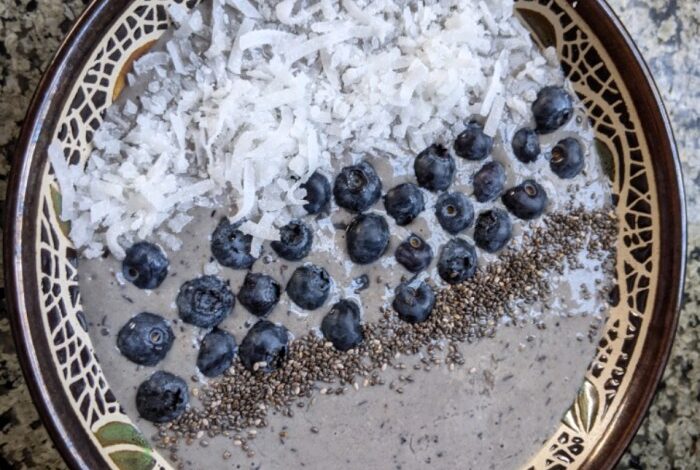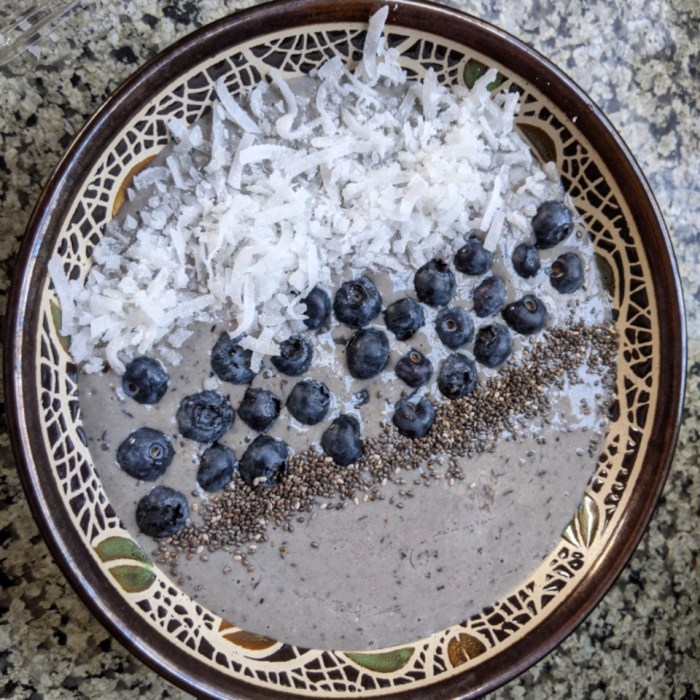
Overnight Oats Blueberry Smoothie Bowl: A Delicious & Healthy Breakfast
Overnight oats blueberry smoothie bowl – it’s a breakfast dream come true! This simple yet satisfying dish is packed with nutrients, flavor, and convenience. Imagine waking up to a creamy, colorful bowl brimming with the sweet goodness of blueberries and the satisfying texture of overnight oats.
This recipe is perfect for those busy mornings when you need a quick and healthy breakfast that keeps you feeling energized throughout the day.
The base of this delicious creation is overnight oats, a versatile and nutritious breakfast staple. Overnight oats are a great way to start your day because they are easy to prepare, packed with fiber, and customizable to your taste. Then we add blueberries, a superfood bursting with antioxidants and flavor.
These tiny berries complement the oats perfectly, adding a touch of sweetness and a burst of color. The final touch is the smoothie bowl transformation, where we blend the overnight oats with the blueberries, creating a smooth and creamy texture.
We top it off with a variety of delicious and healthy ingredients for a breakfast bowl that’s both satisfying and visually appealing.
Blueberry Power

These tiny blue gems are packed with nutrients and antioxidants, making them a superfood addition to your smoothie bowl. Not only do blueberries contribute to a healthy lifestyle, but they also bring a burst of sweet and tangy flavor that perfectly complements the creamy base of your overnight oats.
Overnight oats blueberry smoothie bowls are a great way to start your day with a healthy and delicious breakfast. But if you’re looking for a sweet treat after dinner, check out these best peach dessert recipes for some inspiration.
You can even add some diced peaches to your overnight oats for a little extra flavor and sweetness!
Nutritional Benefits
Blueberries are a powerhouse of nutrients, offering a wide range of health benefits. They are an excellent source of vitamin C, which supports immune function and collagen production. Blueberries are also rich in antioxidants, particularly anthocyanins, which are responsible for their vibrant blue color.
These antioxidants have been linked to various health benefits, including reducing inflammation, protecting against heart disease, and improving brain function.
My overnight oats blueberry smoothie bowl is a morning staple, and lately, I’ve been adding a touch of nutty sweetness with brown butter. For a quick and easy way to brown butter, check out this brown butter in the microwave guide.
The nutty flavor complements the tart blueberries beautifully, making for a truly decadent and satisfying breakfast.
Flavor Enhancement
The sweet and slightly tart flavor of blueberries provides a refreshing contrast to the creamy texture of overnight oats. Their natural sweetness reduces the need for added sugar, making your smoothie bowl a healthier option. Blueberries also add a delightful burst of flavor, enhancing the overall taste experience.
Preparation Tips
Blueberries are incredibly versatile and easy to incorporate into your smoothie bowl. You can use them fresh, frozen, or even dried.
- Fresh Blueberries:For a vibrant and juicy flavor, use fresh blueberries. Simply wash them thoroughly and add them to your smoothie bowl. You can even top them with a few extra fresh blueberries for a beautiful presentation.
- Frozen Blueberries:Frozen blueberries are a convenient option and add a refreshing coolness to your smoothie bowl. They also help to create a thicker, more satisfying texture. Simply add them directly to your blender when making your smoothie.
- Dried Blueberries:Dried blueberries provide a concentrated burst of flavor and can be used as a topping for your smoothie bowl. They offer a chewy texture and a slightly tangy sweetness.
Visual Representation
Blueberries can be incorporated into your smoothie bowl in various ways, creating a visually appealing and delicious masterpiece.
Starting my day with a refreshing overnight oats blueberry smoothie bowl is a perfect way to fuel up for a busy morning. However, when I’m craving something savory and warm, I love switching things up with a bowl of spicy pumpkin pork noodles.
The combination of sweet pumpkin, savory pork, and spicy chili flakes is just irresistible. But no matter what I choose, I always make sure to have a balanced and delicious meal to start my day.
- Scattered on Top:Create a visually appealing pattern by scattering fresh or frozen blueberries on top of your smoothie bowl. You can arrange them in a circle, a line, or a random pattern.
- Swirled Into the Base:Blend a handful of blueberries into your smoothie base for a subtle blue hue and a burst of flavor. You can create swirls by carefully adding the smoothie to the bowl.
- Layered with Other Toppings:Layer your smoothie bowl with different toppings, such as granola, sliced bananas, and a sprinkle of blueberries. This creates a visually appealing and textural contrast.
Smoothie Bowl Transformation
The overnight oats are ready, and you’re eager to transform them into a vibrant smoothie bowl. But how do you achieve that perfect, thick, and creamy consistency? Let’s explore the process and discover some tips for creating a smoothie bowl that’s both visually appealing and delicious.
Blending Technique for Smoothie Bowl Consistency
Blending overnight oats into a smoothie bowl consistency requires a specific approach to achieve the desired texture. The key is to start with a thick, creamy base, then gradually add liquid until you reach the right consistency.
- Start with a Thick Base:The overnight oats should be thick and creamy, almost like a pudding. This provides the foundation for a dense and flavorful smoothie bowl. If your oats are too thin, you can add more oats or reduce the liquid in the original recipe.
- Gradually Add Liquid:Begin by adding a small amount of liquid, such as milk, yogurt, or juice, to the blended oats. Blend until smooth, then gradually add more liquid until you reach the desired consistency. This allows you to control the thickness and prevent over-blending, which can result in a watery smoothie.
- Use a High-Speed Blender:A high-speed blender is essential for achieving a smooth and creamy texture. It effectively breaks down the oats and creates a velvety consistency. If you don’t have a high-speed blender, you can try using a food processor, but the results may be less consistent.
- Pulse and Blend:Instead of blending continuously, try pulsing the blender in short bursts. This allows the oats to break down evenly and prevents them from becoming too smooth. You can also use a tamper to push the oats down towards the blades for more efficient blending.
Variations and Inspirations: Overnight Oats Blueberry Smoothie Bowl
The beauty of overnight oats lies in its adaptability. It’s a blank canvas for creativity, allowing you to explore endless flavor combinations and textures. Don’t be afraid to experiment with different fruits, vegetables, and toppings. The possibilities are endless, and your taste buds will thank you for it.
Incorporating Different Fruits and Vegetables
Adding fruits and vegetables to your overnight oats is a great way to boost the nutritional value and add a burst of flavor. Choose fruits that are in season for the best taste and value. For example, berries like strawberries, raspberries, and blueberries are perfect for a summer smoothie bowl.
In the fall, you can use apples, pears, and pomegranates. Here are some ideas for incorporating different fruits and vegetables:
- Tropical Delight:Mango, pineapple, and banana create a vibrant and tropical smoothie bowl.
- Green Power:Spinach, kale, and kiwi provide a healthy dose of greens while adding a refreshing twist.
- Citrus Burst:Orange, grapefruit, and lemon add a tangy and zesty flavor.
- Berrylicious:A mix of berries, like blueberries, raspberries, and strawberries, offers a classic and delicious combination.
Unique Flavor Combinations, Overnight oats blueberry smoothie bowl
Think outside the box and create your own unique flavor combinations. Here are some inspiring ideas:
- Chocolate Peanut Butter Dream:Combine peanut butter, cocoa powder, and banana for a decadent treat.
- Ginger Spice:Add grated ginger, cinnamon, and nutmeg for a warm and comforting flavor.
- Coconut Mango Tango:Combine mango, coconut milk, and shredded coconut for a tropical paradise.
- Matcha Green Tea:Blend matcha powder, banana, and almond milk for a refreshing and energizing smoothie bowl.
Making the Smoothie Bowl More Visually Appealing
Presentation is key when it comes to smoothie bowls. Here are some tips for making your creation visually appealing:
- Use colorful toppings:Add a variety of colorful fruits, nuts, seeds, and granola for a visually stunning and appetizing presentation.
- Create patterns and designs:Use a spoon or a small knife to create swirls, lines, or geometric patterns in the smoothie bowl.
- Layer the ingredients:Create a visually appealing layered effect by adding different toppings in a specific order.
- Choose a beautiful bowl:Use a bowl that complements the colors and textures of your smoothie bowl.
Smoothie Bowl Presentation Ideas
- Tropical Paradise:A vibrant smoothie bowl with mango, pineapple, and banana, topped with shredded coconut, toasted almonds, and a drizzle of honey.
- Berry Bliss:A classic smoothie bowl with mixed berries, topped with granola, chia seeds, and a sprinkle of fresh mint.
- Green Goddess:A refreshing smoothie bowl with spinach, kale, and kiwi, topped with sliced strawberries, blueberries, and a drizzle of maple syrup.
- Chocolate Peanut Butter Dream:A decadent smoothie bowl with peanut butter, cocoa powder, and banana, topped with chopped peanuts, chocolate chips, and a drizzle of peanut butter.






